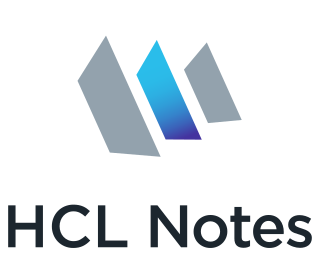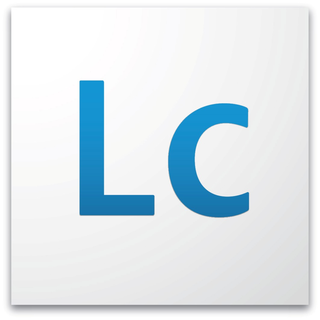Active Directory (AD) is a directory service developed by Microsoft for Windows domain networks. Windows Server operating systems include it as a set of processes and services. Originally, only centralized domain management used Active Directory. However, it ultimately became an umbrella title for various directory-based identity-related services.

HCL Notes is a proprietary collaborative software platform for Unix, Windows, Linux and macOS, sold by HCLTech. The client application is called Notes while the server component is branded HCL Domino.
A content management system (CMS) is computer software used to manage the creation and modification of digital content . A CMS is typically used for enterprise content management (ECM) and web content management (WCM).

WebGUI is an open-source content management system written in Perl and released under the GNU General Public License.
DocuShare is a content management system developed by Xerox Corporation. DocuShare makes use of open standards and allows for managing content, integrating it with other business systems, and developing customized and packaged software applications.
A web content management system is a software content management system (CMS) specifically for web content. It provides website authoring, collaboration, and administration tools that help users with little knowledge of web programming languages or markup languages create and manage website content. A WCMS provides the foundation for collaboration, providing users the ability to manage documents and output for multiple author editing and participation. Most systems use a content repository or a database to store page content, metadata, and other information assets the system needs.

Microsoft Office 2007 is an office suite for Windows, developed and published by Microsoft. It was officially revealed on March 9, 2006 and was the 12th version of Microsoft Office. It was released to manufacturing on November 3, 2006; it was subsequently made available to volume license customers on November 30, 2006, and later to retail on January 30, 2007, shortly after the completion of Windows Vista. The ninth major release of Office for Windows, Office 2007 was preceded by Office 2003 and succeeded by Office 2010. The Mac OS X equivalent, Microsoft Office 2008 for Mac, was released on January 15, 2008.
Enterprise content integration (ECI) is a marketing buzzword for middleware software technology. It is often used within large organizations, that connect various types of computer systems that manage documents and digital content. ECI systems often work in tandem with other technologies such as enterprise content management, document management, groupware, and records management. It takes a decentralized approach in order to manage content from various resources. ECI implementations exist on a tier above the organization's existing software and provide wide-ranging search, indexing, and access functions.

Adobe LiveCycle Enterprise Suite (ES4) is a service-oriented architecture Java EE server software product from Adobe Systems used to build applications that automate a broad range of business processes for enterprises and government agencies. LiveCycle ES4 is an enterprise document and form platform that allows capturing and processing information, delivering personalized communications, and protecting and tracking sensitive information. It is used for purposes such as account opening, services, and benefits enrollment, correspondence management, requests for proposal processes, and other manual-based workflows. LiveCycle ES4 incorporates new features with a particular focus on mobile devices. LiveCycle applications also function in both online and offline environments. These capabilities are enabled through the use of Adobe Reader, HTML/PhoneGap, and Flash Player clients to reach desktop computers and mobile devices.
Nuxeo is a software company making an open source content management system.

SharePoint is a web-based collaborative platform that integrates natively with Microsoft 365. Launched in 2001, SharePoint is primarily sold as a document management and storage system, although it is also used for sharing information through an intranet, implementing internal applications, and for implementing business processes.

Box, Inc. is a public company based in Redwood City, California. It develops and markets cloud-based content management, collaboration, and file sharing tools for businesses. Box was founded in 2005 by Aaron Levie and Dylan Smith. Initially, it focused on consumers, but around 2009 and 2010 Box pivoted to focus on business users. The company raised about $500 million over numerous funding rounds, before going public in 2015. Its software allows users to store and manage files in an online folder system accessible from any device. Users can then comment on the files, share them, apply workflows, and implement security and governance policies.

FileNet, a company acquired by IBM, developed software to help enterprises manage their content and business processes. FileNet P8, their flagship offering, is a framework for developing custom enterprise systems, but it can be used as-is.
Microsoft Forefront Identity Manager (FIM) is a state-based identity management software product, designed to manage users' digital identities, credentials and groupings throughout the lifecycle of their membership of an enterprise computer system. FIM integrates with Active Directory and Exchange Server to provide identity synchronization, certificate management, user password resets and user provisioning from a single interface.
Document Capture Software refers to applications that provide the ability and feature set to automate the process of scanning paper documents or importing electronic documents, often for the purposes of feeding advanced document classification and data collection processes. Most scanning hardware, both scanners and copiers, provides the basic ability to scan to any number of image file formats, including: PDF, TIFF, JPG, BMP, etc. This basic functionality is augmented by document capture software, which can add efficiency and standardization to the process.

GroupWise is a messaging and collaboration platform from OpenText that supports email, calendaring, personal information management, instant messaging, and document management. The GroupWise platform consists of desktop client software, which is available for Windows,, and the server software, which is supported on Windows Server and Linux.






